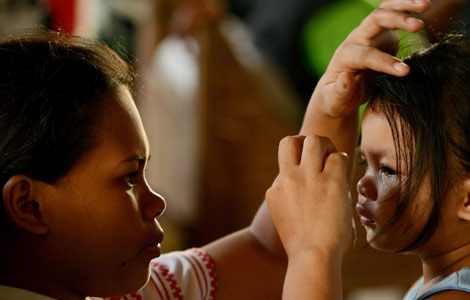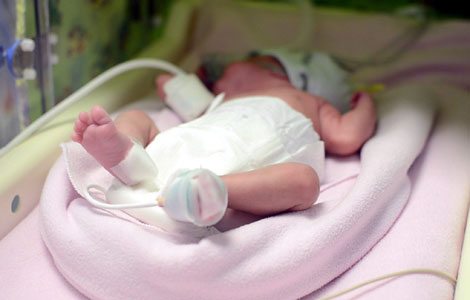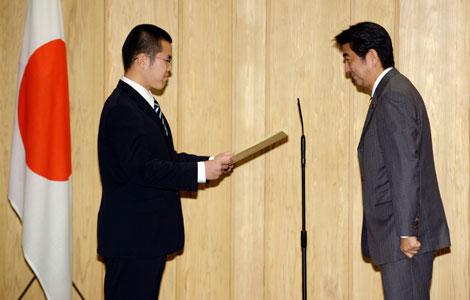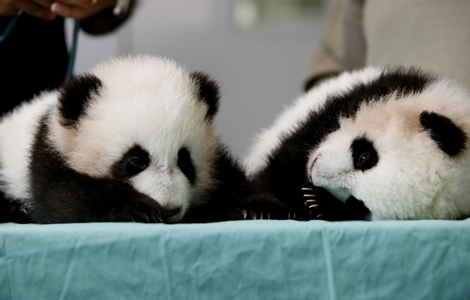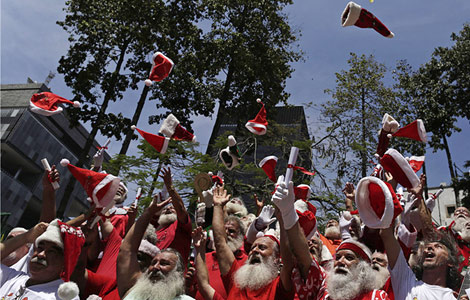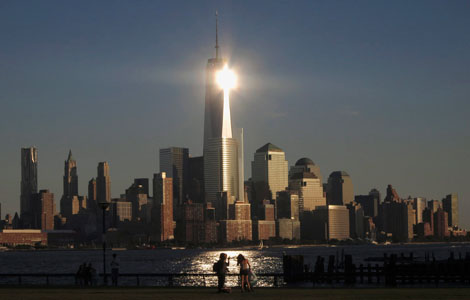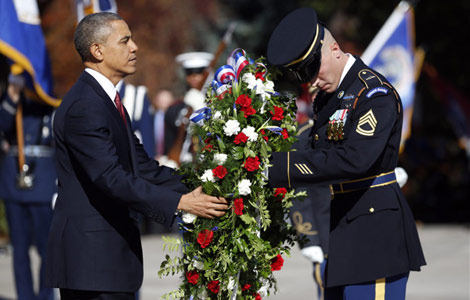

|
Jimmy Deenihan says Ireland will focus on sending various troupes, performers and programs from cultural institutions over the year. Provided to China Daily |
A former Gaelic football player and now Ireland's culture minister, Jimmy Deenihan has switched his ambitions from scoring on the pitch to forging cultural ties
Members of Ireland's Riverdance troupe have been touring China recently, but theirs were not the only Irish feet moving through the country quickly. Jimmy Deenihan, the nation's culture minister and an Irish gaelic football player, touched down at Beijing Capital International Airport on a Thursday afternoon and went almost immediately to talks with his Chinese counterpart Cai Wu.
"I was very impressed with his knowledge of Ireland - he visited Ireland in 2010 - and he signed a memorandum of understanding with my predecessor to promote culture and collaboration between the two countries," Deenihan says of the meeting.
The next day was a blitz of meetings, from the National Center for the Performing Arts to the National Library. Later, at the Irish embassy, he presented awards to 25 young lawyers who had returned from a six-month exchange in Dublin.
"I don't think we slept for 36 hours," says the 60-year-old former captain of Kerry, smiling brightly as if such a run was still all in a day's work.
Deenihan was in China over the New Year weekend for several reasons. Ireland has assumed the revolving EU presidency for the next six months, and the minister seized the chance to promote some key programs in Beijing. Ireland will be the country of honor at this year's International Spring Festival at Chaoyang Park. Deenihan sees that as a springboard to make 2014 a "Year of Ireland" in China.
"We'll focus on sending various groups, troupes, performers - including professional troupes such as Riverdance - and programs from cultural institutions over the year," he says.
Those include an Irish literary festival, the focus of his meetings at the National Library.
"The National Library here is the third-largest national library in the world." he says.
"I was really taken with the number of Irish books and the translations into Chinese. There was James Joyce's most recent translation, Finnegan's Wake, and Ulysses." The latter classic, he says, is widely available in Chinese - despite being a chewy meal of literature for native-English readers. That is a tribute, he says, to the cultural appreciation between two civilizations that each goes back 5,000 years.
While Joyce may be the best-known Irish author, Deenihan saw other classics by Beckett, Shaw, Swift and Heaney - "and works right up to modern writers such as Colm Toibin, Emma Donoghue and Sebastian Barry." Some, such as Donoghue, are no strangers to literary festivals in China, and Deenihan is proud that the Irish government subsidizes Irish writers traveling abroad with their words. "That helps make something like a literary festival happen."
Deenihan was thrilled to have a tour of Beijing's National Center for the Performing Arts, and his talks with NCPA about having some Year of Ireland events there made him optimistic.
"I was really taken by the fantastic architecture," he says.
"I know it's called 'The Egg', but it definitely rivals the opera house in Sydney in terms of design and use of space. Beijing is very lucky to have it."
He is keen about another special component of plans for next year.
"We're going to be able to offer a four-week residency for a top Chinese artist at Cill Rialaig, an old farming village that was restored as an artists' retreat. We were delighted to give this present to the Chinese minister to nominate a really top artist of his choice."
Over the years since it was opened, the Cill Rialaig center has attracted 2,500 artists from all over the world, he says, adding that a hundred times that many have applied for residencies there.
"It is regarded as a center of imagination and has been since the monks of nearby Skellig Michael illuminated some of the finest manuscripts of that time. Like the monks were 1,400 years ago, artists are now inspired by the light and the peace of that location."
One highlight of his short four-day visit was a trip to Beijing University of Technology. "They have established a joint campus now with University College Dublin - its name is Beijing-Dublin International College - and the first of the 25 undergraduates will be going to Dublin on field work in January. They have a designated area in the university for the college, and after five years we all hope it will formally become its own university."
If he could give Chinese friends one new impression about Ireland, it would be that the country is both a treasure trove of culture and a modern source of quality food.
"We can offer China high-quality dairy products and meat that would match if not surpass any country's," he says, noting that he would just come from a meeting of the Irish Dairy Board, which has an office in Beijing.
If all of this is not enough to keep an Irish culture minister busy, the international celebration of St Patrick's Day is just weeks away.
"That's a blessing - there are few countries in the world that get the kind of attention that Ireland gets on St Patrick's Day. So we're very fortunate. In Beijing and Shanghai it has become a major event - in America, it's the only day of the year where they totally close down Fifth Avenue for the parade."
At the last "diaspora forum" in Dublin Castle in October 2011, Deenihan suggested branding St Patrick's Day as an international day of Irish culture. He would like to develop a common web portal for worldwide St Patrick's Day events, including in Ireland.
"St Patrick's Day is not just a commitment to culture or to green beer," he says, "but to St Patrick himself as well.
"At the time he converted Ireland to Christianity, Ireland was a very strong pagan country, with our own gods, and the fact that he succeeded showed first of all what a good communicator he was," Deenihan says. "But also he was the most influential person who ever came to Ireland.
"So he's a figure of huge national and international significance, and that hasn't been fully explored, I think, because when you look at the contribution that Irish priests and monks during the Dark Ages of Europe made to save the written record of Western civilization in medieval times.
"But St Patrick's Day celebrations are also a reflection of the Irish openness and sense of humor and a demonstration of what's the best of the Irish around the world. The Irish personality comes through on St Patrick's Day."
michaelpeters@chinadaily.com.cn
(China Daily 02/01/2013 page29)
